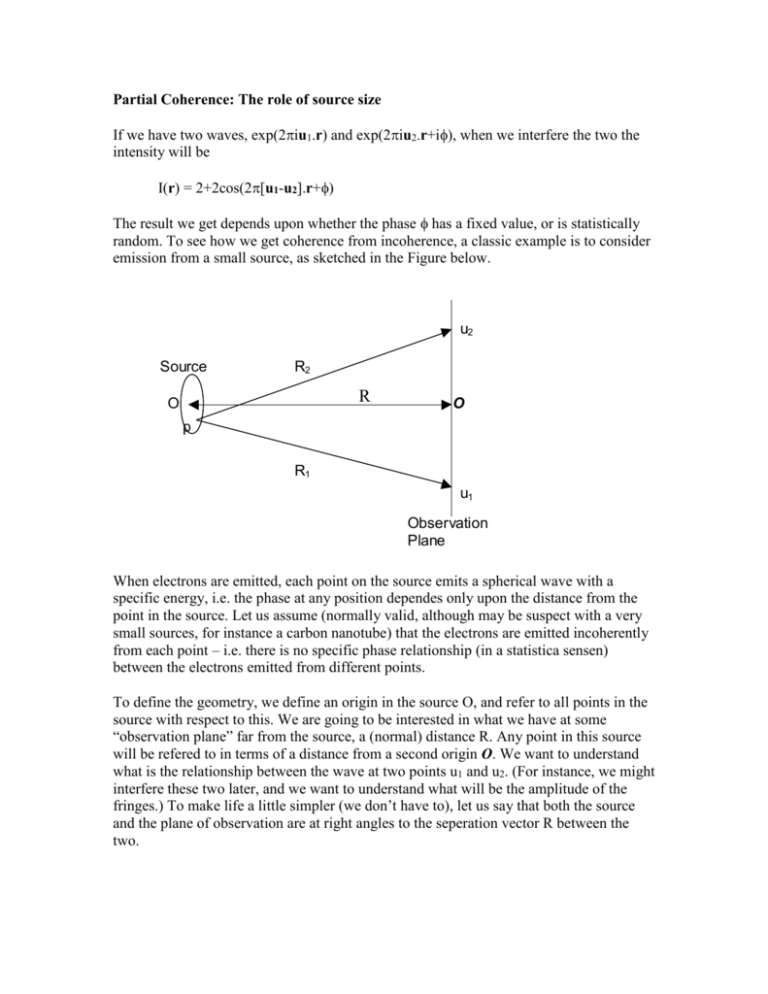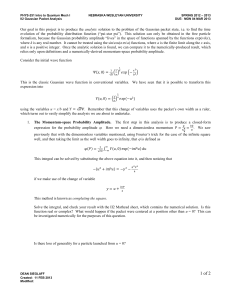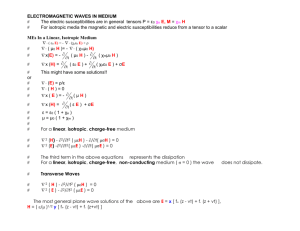notes
advertisement

Partial Coherence: The role of source size
If we have two waves, exp(2iu1.r) and exp(2iu2.r+i), when we interfere the two the
intensity will be
I(r) = 2+2cos(2[u1-u2].r+)
The result we get depends upon whether the phase has a fixed value, or is statistically
random. To see how we get coherence from incoherence, a classic example is to consider
emission from a small source, as sketched in the Figure below.
u2
Source
R2
R
O
O
p
R1
u1
Observation
Plane
When electrons are emitted, each point on the source emits a spherical wave with a
specific energy, i.e. the phase at any position dependes only upon the distance from the
point in the source. Let us assume (normally valid, although may be suspect with a very
small sources, for instance a carbon nanotube) that the electrons are emitted incoherently
from each point – i.e. there is no specific phase relationship (in a statistica sensen)
between the electrons emitted from different points.
To define the geometry, we define an origin in the source O, and refer to all points in the
source with respect to this. We are going to be interested in what we have at some
“observation plane” far from the source, a (normal) distance R. Any point in this source
will be refered to in terms of a distance from a second origin O. We want to understand
what is the relationship between the wave at two points u1 and u2. (For instance, we might
interfere these two later, and we want to understand what will be the amplitude of the
fringes.) To make life a little simpler (we don’t have to), let us say that both the source
and the plane of observation are at right angles to the seperation vector R between the
two.
Let us start with some point p at the source. The phase of the wave at u1 (and u2) will
depend upon the distance it has traveled, which we will call R1. Dealing with everything
as vectors,
R1 = R + u1 – p
If we say that the phase of the wave when it is emitted is zero, the phase at u1 will be
= 2|R1|/
where is the wavelength. We can write a similar equation for the phase of the wave at
R2. The phase difference between the waves at u1 and u2 will therefore be:
= 2|R1|-|R2|}/
We now want to convert from R1 and R2 to something a little more manageable. We can
write (exact, no approximations)
|R1| = {R2 + (u1-p)2}
If R is large, we can expand this as a Taylor series and neglect terms with smaller values
|R1| = R{1 + (u1-p)2/R2} R{1+(u1-p)2/2R2} R+(u1-p)2/2R
Therefore, substituting these in and calculating the phase difference
2/R+(u1-p)2/2R - R-(u2-p)2/2R]
/(u1-p)2/R - (u2-p)2/R]
/(u1)2 - (u2)2/}R - 2{u1-u2}p/R]
The interference depends not on the difference between the phases, rather exp(i[])
which we can write as
exp(i[]) = exp(i/(u1)2 - (u2)2}/R - 2{u1-u2}p/R]_
To simplify this, let’s introduce a new variable s=p/(R), and convert to vectors for s, u1
and u2 so that
exp(i[]) = exp(i(u1)2 - (u2)2 }/(R - 2i{u1-u2}.s)
Now, the last stage. Every point in the source will emit, but they do not all have to emit
the same number of electrons per second. Let us describe the emission from each point by
some function S(s) (using s as a vector rather than p). The amplitude of (for instance)
fringes due to interference later down the column from the waves at u1 and u2 will be
determined by summing the contributions from all the points in the source, i.e.
<exp(i[])> = exp(i(u1)2 - (u2)2}/R - 2i{u1-u2}.s)S(s)ds
or
<exp(i[])> = exp(i(u1)2 - (u2)2/R}) exp(-2i{u1-u2}.s)S(s)ds
The first term on the right does not really matter – it’s amplitude is 1 so we can ignore it
in many cases. Introducing a new term to describe our final result,
<exp(i[])> = (u1,u2) = exp(-2i{u1-u2}.s)S(s)ds
The term (u1,u2) is called the “mutual coherence” between the two points u1 and u2. If
it was zero, the two are completely incoherent and cannot interfere. If it is one, the two
are completely coherent. The smaller the source, the more “coherence” there is between
the two different waves – hence small sources are in general better.
Going back to the original example used at the top of this section, in general we can
write:
I(r) = 2+2(u1,u2) cos(2[u1-u2].r+)
where is the average phase (which will include the term that we dropped earlier).
The idea that something small increases the coherence occurs in many places when you
use any type of microscope. For instance, suppose we have a very large source, e.g. a
tungsten filament or an LaB6 tip where the region from which there is emission can be
several microns in size. In this case we can consider the condensor aperture to be
incoherently illuminated (only points exceedingly close togethor are coherent). In this
case two points at the object have a mutual coherence which is determined by the size of
the condensor aperture – the smaller it is, the more coherence there is.
An important final point. When we create an image, we are really only doing this (in
almost all cases) with the coherent part of the wave. We Fourier transform waves from
one plane to another, e.g. from the object to the diffraction plane (objective aperture
plane) by summing contributions – which we can only do if the contributions are
coherent. As an example, the image of the source on the sample is formed from the
electrons which are coherent across the condenser aperture. The size of the source
(illuminated region approximately) is going to be determined largely by how much
coherence we have. If we demagnify the source, we are expanding the region of
coherence across the condenser aperture, thereby reducing our illumination intensity
(longer exposures). A small source (e.g. a FEG) will save us a lot of effort, giving more
electrons in a small region which is better for STEM operation. A FEG source does have
other problems (stability, cost) so it is not always best.









